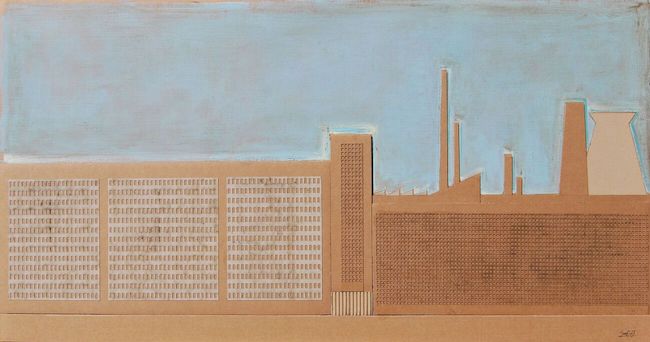Alcuni artisti contemporanei si trovano ad aver mosso i primi passi in dinamico Ventesimo secolo, quello nel quale le sperimentazioni e le innovazioni erano parte imprescindibile del percorso creativo; trovarsi nel secolo successivo con tutte le modificazioni, le trasformazioni compiute dall’arte proprio in virtù di quel passato significa spesso fare i conti con differenti anime espressive, con diversi approcci pittorici che da un lato sono necessari per mantenere vivi i linguaggi considerati avanguardistici nel momento in cui sono stati ideati, e dall’altro per non sottostare alla regola secondo la quale un artista debba necessariamente attenersi a una sola cifra espressiva. Il protagonista di oggi muove i primi passi nel mondo della creatività esattamente in quell’eclettico secolo che ha cambiato completamente le regole precedenti, ha sovvertito tutte le norme accademiche creandone così di nuove e inaspettate, e forse è addirittura stato in grado di andare persino oltre perché ha dato un tocco personale a tutti gli stili che nel corso del tempo hanno contraddistinto la sua produzione.
L’artista Sauro Cecchi, nel corso della sua carriera, ha portato avanti contemporaneamente tre linguaggi artistici che fanno parte di sé, come se a nessuno fosse possibile rinunciare poiché appartengono tutti alla sua essenza più profonda, quella che non riesce a trovare realizzazione attraverso un solo modo di osservare le cose, la vita e di conseguenza l’arte, così crea il Gruppo Tre per sottolineare quanto per lui sia essenziale, vitale quasi, continuare a spostarsi all’interno di quell’intento espressivo che ha bisogno di misurarsi con il Paesaggismo, con il Costruttivismo Astratto e infine con il Neoplasticismo. Sembrano quasi in antitesi questi tre linguaggi artistici eppure riescono a convivere all’interno del medesimo mondo creativo, quasi come se le sue tre anime avessero bisogno di emergere una in alternanza all’altra senza soluzione di continuità. Per quanto riguarda il Neoplasticismo, movimento nato inizialmente come stile pittorico in antitesi all’opulenza e alla tendenza decorativa dell’Art Nouveau, e contraddistinto da linee rette, forme geometriche rigorose e limitate al quadrato e al rettangolo, e dalla presenza dei soli colori primari, il rosso, il giallo, il nero, il bianco e il blu, Sauro Cecchi ne dà una sua propria versione, forse più affine alla modificazione successiva iniziata da Theo Van Doesburg a seguito del suo trasferimento a Weimar e all’insegnamento presso la Bauhaus.
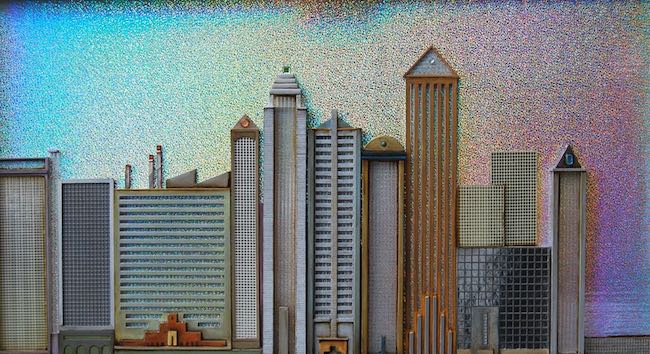
Dunque la gamma cromatica dell’originale De Stijl è superata e ampliata a varie tonalità sfumate e tendenzialmente tenui, mentre invece è mantenuto il rigore geometrico seppur ampliato anche alle diagonali e alle forme a ogiva e tondeggianti; in questo caso l’approccio di Sauro Cecchi è architettonico ma anche in fondo un po’ immaginario, visionario soprattutto per gli sfondi che accompagnano quelle città di fantasia che potrebbero anche costituire il futuro in cui l’umanità vivrà di qui a qualche anno. La struttura dei palazzi narrati nel suo Neoplasticismo è imponente, cristallina per la leggerezza dei vuoti costituiti dai vetri che riflettono la luce, e infine innovativa per le linee oblique e tendenti verso l’altro che sembrano alleggerire e dare un aspetto futuristico a quegli agglomerati urbani in cui non manca l’elemento immaginativo, quelle piccole galassie e quei cieli lattiginosi che inducono l’osservatore a domandarsi se i paesaggi appartengano a un mondo parallelo a quello in cui l’umanità abita.
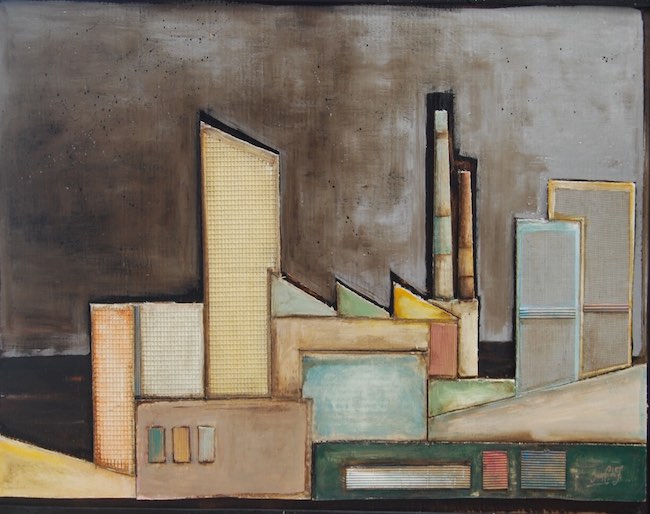
Per quanto riguarda il Costruttivismo Astratto Sauro Cecchi si ispira da un lato all’astrazione del Suprematismo di Kazimir Malevich, dall’altro alla trasformazione del Futurismo Russo di Vladimir Tatlin, sia dal punto di vista dell’utilizzo di materiali innovativi con cui diede vita a opere in bassorilievo e sia per il rifiuto di considerare l’arte come fine a se stessa, senza alcun utilizzo pratico; di fatto Cecchi proprio con questo stile decide di mettere in evidenza il concetto del riciclo, pur però mantenendo un approccio informale, dando nuova vita a oggetti che altrimenti finirebbero al macero come ritagli di cartone, legni, reti in metallo, tutti spunti per andare a costruire un’immagine informale contraddistinta dalla geometricità irregolare e isolata, dunque non più contigua come nel caso del Costruttivismo Astratto, bensì inserita in maniera casuale all’interno della composizione.
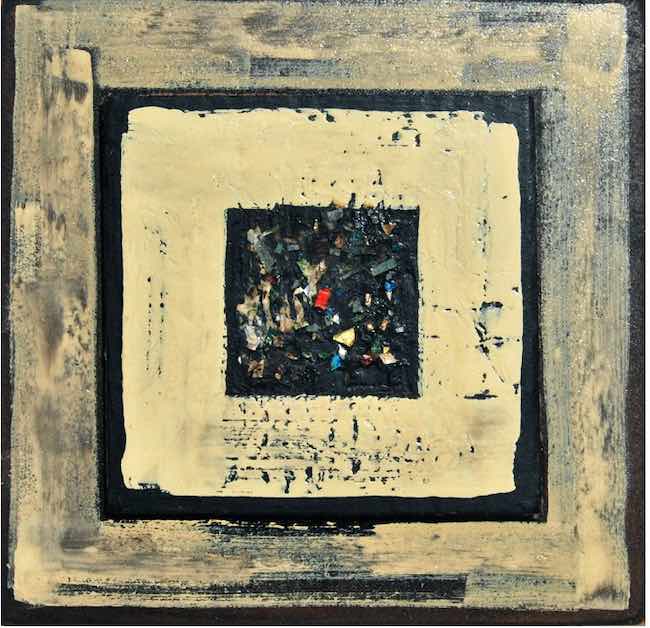
Dunque l’intenzione è quella di rendere utile tutto ciò che diversamente avrebbe terminato il suo corso esistenziale evitando di accumulare rifiuti poi lentamente smaltibili, ma anche di mantenere un approccio informale in cui l’astrazione si associa al concetto che spinge verso la riflessione, la meditazione, alla scoperta del senso che sfugge proprio perché lo sguardo, non riuscendo a riconoscere ciò che è abituato a vedere, tende ad andare verso il significato del messaggio dell’artista, perdendosi dentro il proprio percorso mentale ma al tempo stesso interrogandosi esattamente su quell’uso e sulla capacità dell’artista di trasformare in arte qualunque cosa.
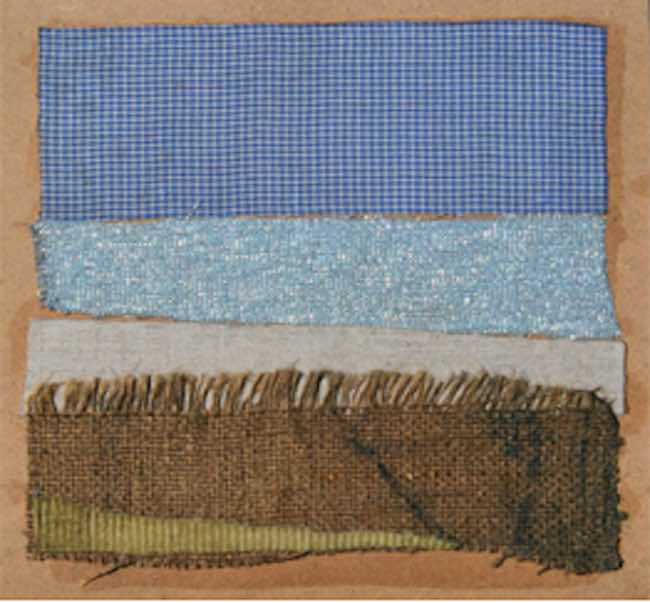
Nel suo lato Paesaggista invece Sauro Cecchi sembra compiere quel cammino di ritorno all’ordine che si era verificato verso il secondo ventennio del Novecento, quando cioè tutto l’ardore degli astrattisti aveva introdotto la rivoluzione espressiva che aveva costituito una sovversione dell’arte accademica tradizionale e soprattutto un modo per sottolineare quanto il gesto plastico e il suo risultato finale fossero superiori a qualsiasi bisogno di legarsi alla realtà conosciuta; nella fase di ritorno a una figurazione più tradizionale, sebbene ormai verso un nuovo concetto di approccio pittorico, emersero il gruppo Novecento di Milano, di cui fu tra i massimi esponenti Mario Sironi, ma anche la Scuola Romana, e poi i maestri Carlo Carrà e Giorgio Morandi, tutti con la stessa intenzione di sottolineare la bellezza del paesaggio, rivisitato in chiave intimista e quasi rarefatto dal punto di vista visivo, spesso privo della presenza umana e costituito da un senso di solitudine quasi metafisica.
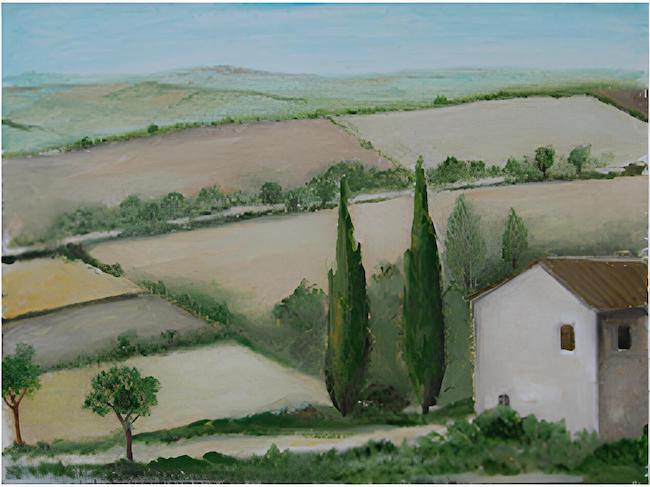
Ed è qui che si allaccia il lato figurativo di Sauro Cecchi, in quel lasciare che il suo sguardo si perda, emozionandosi, nei panorami della sua regione, le Marche, lasciando fuoriuscire la malìa che le colline che circondano il suo studio d’artista esercitano su di lui e che si trasforma sulla tela in suggestione silenziosa, in approccio contemplativo sulla bellezza che si associa alla poesia visiva delle colline che gradatamente si spingono verso il mare, poco lontano. Le atmosfere di Cecchi sono vicine per evocazione percettiva a quelle di Carrà, di Morandi e a quelle del suo conterraneo Osvaldo Licini che è stato per lui grande fonte di ispirazione, pur mantenendo quella geometricità figurativa che contraddistingue il suo approccio artistico, e che è facilmente riscontrabile negli edifici, nelle case accompagnate dalla suggestione della luna, dall’intuizione della lieve percezione del vento ma soprattutto dal silenzio con cui avvolge i panorami che colpiscono la sua attenzione.
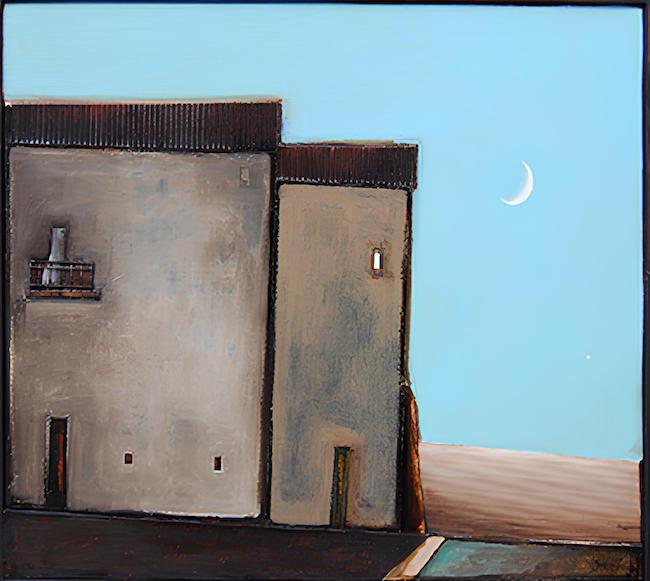
Le tre anime di Sauro Cecchi, che portano alla memoria le tre personalità compositive del compositore romantico Robert Schumann, fanno tutte parte del Gruppo Tre, un modo per lui di mostrarsi nella pienezza espressiva ma anche per tendere una mano agli artisti della contemporaneità che hanno dimenticato di porsi in relazione, di incontrarsi e di dare vita a quella fucina di idee e di intenti artistici che nel Ventesimo secolo erano stati capaci di creare tutto il nuovo a cui i creativi di oggi si ispirano.
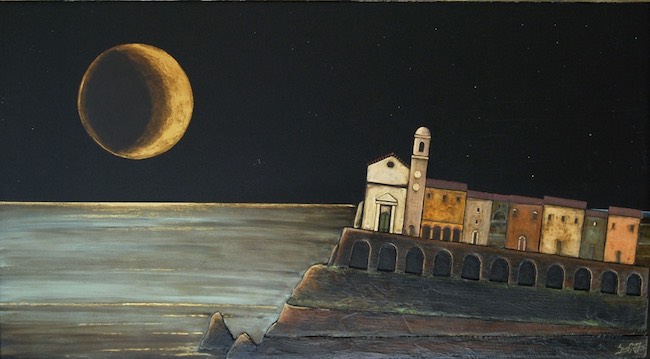
Dunque l’esortazione, nonché il desiderio di Cecchi, che è stato in passato anche Assessore alla Cultura del Comune di Falerone, il paese delle Marche dove abita, e che ha al suo attivo mostre personali e collettive su tutto il territorio nazionale e all’estero, New York, Londra, Parigi e Ginevra, è quello che si generi una rinascita dell’arte dal punto di vista del confronto e dello stimolo reciproco tra gli artisti e i differenti linguaggi espressivi, tanto quanto lui riesce a farli convivere all’interno della sua unica personalità, eclettica, sfaccettata e proprio per questo necessitante di misurarsi con linguaggi differenti eppure incredibilmente tutti in armonia, come se fossero l’uno la conseguenza dell’altro e al contempo anche la premessa. In un continuum che è riuscito ad affascinare collezionisti da ogni parte di Italia e anche dall’estero che continuano a sentirsi conquistati dalla sua arte più razionale e anche da quella emozionale.
SAURO CECCHI-CONTATTI
Email: sauro.cecchi@libero.it
Sito web: www.saurocecchidafalerone.it
Facebook: www.facebook.com/sauro.cecchi.1
Instagram: www.instagram.com/cecchisauro/
Linkedin: www.linkedin.com/in/sauro-c-279952108/
Sauro Cecchi, a long and complex artistic journey between rationality and emotion
Some contemporary artists find themselves having taken their first steps in the dynamic 20th century, one in which experimentation and innovation were an inescapable part of the creative journey; to find oneself in the next century with all the modifications, the transformations accomplished by art precisely because of that past often means coming to terms with different expressive souls, with different pictorial approaches that on the one hand are necessary to keep alive the languages considered avant-garde at the time they were conceived, and on the other hand not to submit to the rule that an artist must necessarily stick to a single expressive figure. Today’s protagonist takes his first steps in the world of creativity exactly in that eclectic century that completely changed the previous rules, subverted all academic norms thus creating new and unexpected ones, and perhaps was even able to go even further because he gave a personal touch to all the styles that over time marked his production.
The artist Sauro Cecchi, throughout his career, has simultaneously pursued three artistic languages that are part of himself, as if none could be renounced since they all belong to his deepest essence, the one that cannot find fulfillment through only one way of observing things, life and consequently art, so he creates Group Three to emphasize how essential, vital almost, it is for him to keep moving within that expressive intent that needs to measure itself against Landscapeism, Abstract Constructivism and finally Neoplasticism. They almost seem to be in antithesis these three artistic languages and yet they manage to coexist within the same creative world, almost as if its three souls need to emerge one in alternation with the other without a solution of continuity. As far as Neoplasticism is concerned, a movement initially born as a painting style in antithesis to the opulence and decorative tendency of Art Nouveau, and marked by straight lines, rigorous geometric forms limited to the square and rectangle, and the presence of only the primary colors, red, yellow, black, white and blue, Sauro Cecchi gives his own version of it, perhaps more akin to the later modification initiated by Theo Van Doesburg following his move to Weimar and teaching at the Bauhaus.
So the chromatic range of the original De Stijl is surpassed and expanded to various shaded and tendentially muted tones, while instead the geometric rigor is maintained albeit also expanded to diagonals and ogive and rounded forms; in this case Sauro Cecchi‘s approach is architectural but also at heart somewhat imaginary, visionary especially for the backgrounds that accompany those fantasy cities that could also constitute the future in which humanity will live a few years from now. The structure of the buildings narrated in his Neoplasticism is imposing, crystalline because of the lightness of the voids constituted by the glass reflecting the light, and finally innovative because of the oblique lines tending toward the other that seem to lighten and give a futuristic aspect to those urban agglomerations in which the imaginative element is not lacking, those small galaxies and those milky skies that induce the observer to wonder if the landscapes belong to a world parallel to the one in which humanity lives. With regard to Abstract Constructivism Sauro Cecchi is inspired on the one hand by the abstraction of Kazimir Malevich‘s Suprematism, and on the other by the transformation of Vladimir Tatlin‘s Russian Futurism, both from the point of view of the use of innovative materials with which he gave life to bas-relief artworks and for the refusal to consider art as an end in itself, without any practical use; in fact, Cecchi precisely with this style decides to highlight the concept of recycling, while still maintaining an informal approach, giving new life to objects that would otherwise end up in the rubble such as cardboard scraps, wood, metal nets, all cues to go to build an informal image marked by irregular and isolated geometricity, therefore no longer contiguous as in the case of Abstract Constructivism, but rather inserted randomly within the composition.
So the intention is to make useful everything that otherwise would have ended its existential course by avoiding accumulating waste then slowly disposable, but also to maintain an informal approach in which abstraction is associated with the concept that pushes toward reflection, meditation, to the discovery of meaning that escapes precisely because the gaze, unable to recognize what it is used to seeing, tends to go toward the meaning of the artist’s message, losing itself within its own mental path but at the same time questioning exactly that use and the artist’s ability to transform anything into art. In his Landscapist side, on the other hand, Sauro Cecchi seems to fulfill that path of return to order that had occurred toward the second two decades of the twentieth century, that is, when all the ardor of the abstractionists had introduced the expressive revolution that constituted a subversion of traditional academic art and, above all, a way of emphasizing how much the plastic gesture and its final result were superior to any need to bind oneself to known reality; in the phase of return to a more traditional figuration, albeit now toward a new concept of pictorial approach, emerged the Novecento group of Milan, of which Mario Sironi was among the greatest exponents, but also the Roman School, and then the masters Carlo Carrà and Giorgio Morandi, all with the same intention of emphasizing the beauty of the landscape, revisited in an intimist key and almost rarefied from a visual point of view, often devoid of human presence and constituted by a sense of almost metaphysical solitude.
And it is here that Sauro Cecchi‘s figurative side is connected, in that letting his gaze get lost, thrilled, in the panoramas of his region, the Marche, letting out the malice that the hills surrounding his artist’s studio exert on him and that is transformed on the canvas into silent suggestion, into a contemplative approach on the beauty that is associated to the visual poetry of the hills that gradually push toward the sea, not far away. Cecchi‘s atmospheres are close in perceptive evocation to those of Carrà, Morandi and those of his fellow countryman Osvaldo Licini, who was a great source of inspiration for him, while maintaining that figurative geometricity that distinguishes his artistic approach, and which is easily found in the buildings, the houses accompanied by the suggestion of the moon, the intuition of the slight perception of the wind but above all by the silence with which he envelops the panoramas that strike his attention. Sauro Cecchi‘s three souls, which bring to mind the three compositional personalities of the Romantic composer Robert Schumann, are all part of the Group Three, a way for him to show himself in the fullness of expression but also to extend a hand to contemporary artists who have forgotten to relate to each other, to meet and to give life to that forge of ideas and artistic intentions that in the 20th century had been able to create all the new that today’s creative people are inspired by. So the exhortation, as well as the desire of Cecchi, who has also been in the past a Cultural Councillor for the Municipality of Falerone, the Marche country where he lives, and who has to his credit solo and group exhibitions throughout the country and abroad, New York, London, Paris and Geneva, is to generate a renaissance of art from the point of view of confrontation and mutual stimulation between artists and different expressive languages, as much as he manages to make them coexist within his unique personality, eclectic, multifaceted and precisely for this reason needing to measure himself with different languages and yet incredibly all in harmony, as if they were one the consequence of the other and at the same time also the premise. In a continuum that has managed to fascinate collectors from all parts of Italy and also from abroad who continue to feel conquered by his more rational and also emotional art.


